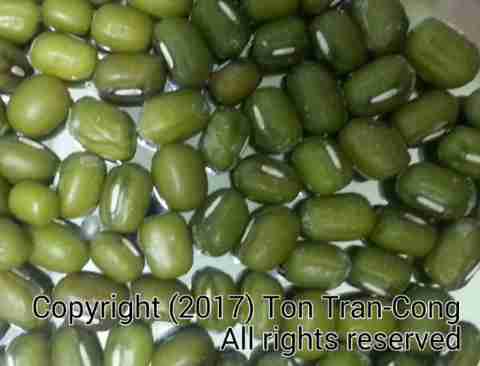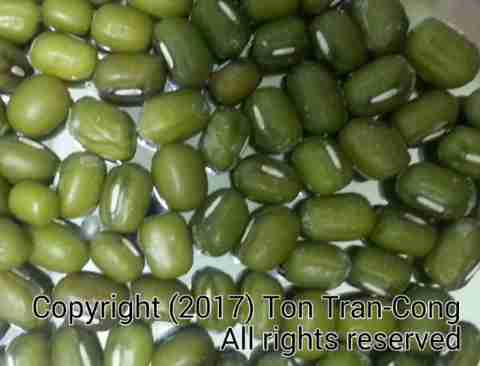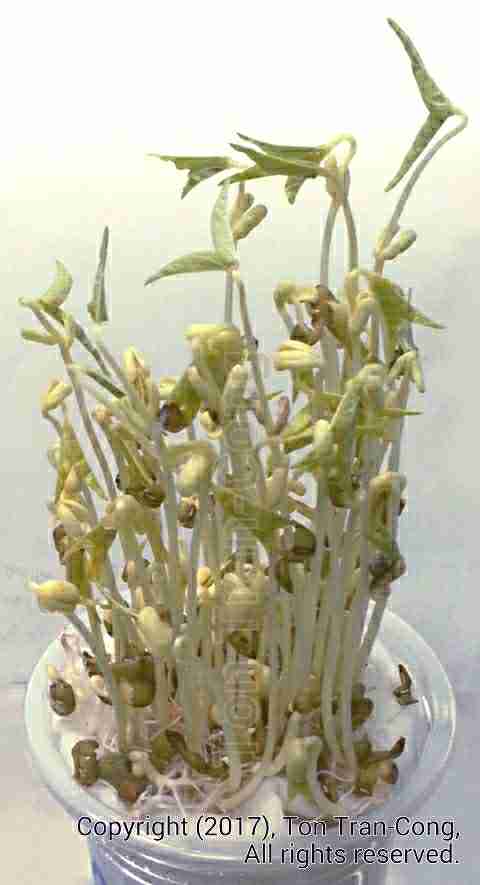Mung Beans as grains for self-reliance
by tonytran2015 (Melbourne, Australia).
Click here for a full, up to date ORIGINAL ARTICLE and to help fighting the stealing of readers’ traffic.
(Blog No.52).
#Mung bean, #sprout, #dietary fiber, #nutrition, #sweet dish, #constipation, #self-reliance #crop #rotation.
Mung Beans as grains for self-reliance.
Nutrition requires a variety of food. For emergency you can eat rice to supply your body with carbohydrate for energy but you also need other food to satisfy the complex nutrition requirements of your body. After rice, mung beans are a versatile type of grains to be kept for prolonged emergency and self-reliance.
1. Advantage of mung beans.
Mung beans are the seeds of the plant species (Vigna radiata) of the family legume of plants. The mung bean plants originated from Thailand more than 2000 years ago (reference [1]). As a legume, each mung bean plant has nodules in its roots containing the symbiotic bacteria rhizobia which fix nitrogen from the atmosphere to enrich, fertilize the soil with natural nitrates. The mung bean plants are therefore a essential crop in crop rotation for growing and restoring self-reliant, self-sustaining gardens (using no chemical fertilizers) after disasters.
The beans are of 5mm size and each bean weighs about 0.070g. They can be used as food in many different ways: They can be boiled to make watery sweet dessert or pasty dessert. They can also be made to germinate to produce new plants to restore the garden or to produce sprouts (before they become small plants) to be eaten as food.
2. Selecting good mung beans.
Figure 1: Mung beans of 5mm size.
The beans are of 5mm size and each bean weighs about 0.070g. Select beans with rounded shape and no wrinkle, no mold, no discoloration on the skin, like in the picture.
3. Storage.
3a. Mung beans are dense and 5kg of mung beans can be stored in a small volume.
3b. Mung beans are easy to store. Storage temperature can be from very cold to up to 35 degree C.
They can be stored in jars placed dry ventilated places. As with any other foods, humidity should be avoided to prevent the growth of mold on them.
It is common for Asian families to keep about 2 kg of them in store for gradual normal consumption in food preparation.
3. Cooking beans for food.
Mung beans can be boiled to make a (watery to thick pasty) dessert food. However this requires long simmering and requires MORE FUEL than cooking rice.
Watery sweet:
The beans are first soaked in clean, warm water for about 6 hours for their green covers to loosen, peel off and be shed. Soaking is carried out in a flat, shallow ceramic or glass container with no more than 3 layers of beans on the bottom and no more than 12mm (half an inch) of water above the top layer of beans. Water should be refreshed every 6hr to remove all secretions from the beans which may inhibit the functioning of neighbour beans. Only a thin layer of water is permitted so that oxygen in the air can diffuse down to the beans to reactivate their inactive cells to make the beans germinate and transform the stored nutrients into a softer form. With this transformation, the beans are softer and it would take shorter time to boil them. Soaking should be discontinued when many beans have tiny (2mm) shoots growing out of them. Further soaking after this time would make the dish less tasty.
The beans are then boiled in much larger amount of simmering water (for about 10 minutes) until the green covering layer of each bean is shed and the two yellow halves inside are softened. Sweetener (cane sugar or palm sugar) is then added and mixture is thoroughly stirred for even mixing. The watery mixture is served and eaten as a sweet dessert drink in South Vietnam.
Thick pasty sweet:
Split mung beans are used in this dish. The split beans are first soaked in clean warm water for about 24 hours for their green covers to loosen, peel off and be shed. Soaking is carried out in a flat, shallow ceramic or glass container with no more than 3 layers of beans on the bottom and no more than 12mm (half an inch) of water above the top layer of beans. Water should be refreshed every 6hr to remove all secretions from the beans which may inhibit the functioning of neighbour beans. Only a thin layer of water is permitted so that oxygen in the air can diffuse down to the beans to reactivate their inactive cells to make the beans germinate and transform the stored nutrients into a softer form. With this transformation, the beans are softer and it would take shorter time to boil them.
The green covering layer is then complete removed and only the yellow half seeds are retained. The yellow halves are then boiled in a minimal amount of simmering water until they are softened. Sweetener (cane sugar or palm sugar) is then added and mixture is thoroughly stirred for even mixing. The thick yellow pasty mixture is served and eaten as a sweet dessert dish in South Vietnam. Boiled coconut milk may also be added as a thin top layer of the mixture.
3. Making mung beans germinate naturally.
Figure 1: Germination of mung beans after 7 days 2 hours in my tiny green house.
My tiny green house:
I used two thickness of washed, clean disposable hand cloth stretched on the top of a disposable plastic drink cup to make a moist base sheet for the beans to germinate. The base sheet was given 5 tea spoons of water twice daily. Another identical cup with a small cut was placed upside down on top of this cup to control the atmosphere around the beans.
The germination into small plants:
Each bean is made up of two halves covered in a thin green skin. The two halves of each bean supply stored materials and energy for the growing of a sprout that will develop into a small mung bean seedling. The sprout grows in length to about 5mm and the two halves of the bean separate (4 days). The sprouts grow longer, until they are about 20mm, then they develop many tiny side roots and this make them look fuzzy. At that time there are two tiny leaves growing from between the two halves of the bean. After the leaves have grown to about double the size of the original bean, the green skin is shed to fall down to the ground (7 days). The two halves of the bean is gradually consumed for the growth of the seedling.
The sprouts are considered tasty when they are about to shed the green cover.
If making plants for the gardens, healthy seedlings should be selected and planted on the ground after they have green leaves and before the nutrient in their half seeds are exhausted.
An average seedling weighs 0.50g and an average bean weighs 0.070g. The mung bean sprouts are considered most tasty when they are 50mm long. In such condition each sprout weighs about 0.35g.
4. Using mung bean sprouts as food.

Figure 1: Mung Bean Sprouts served as a (crunchy) vegetable dish.
The advantage of using this food is that mung bean sprouts can be made from mung beans in any needed quantity in about 2 days (see below). Mung bean sprouts are crunchy, they have high fiber contents. This fiber content makes up the bulk for food under digestion and help prevent constipation caused by the compaction of undigested food residues. However DO NOT EAT sprouts which have become BLUE.
Mung bean sprouts also have good nutritional value. The total weight of sprouts has
16% of it in dietary fiber ,
23% in protein ,
and the rest in carbohydrate. Sprouts also have magnesium, iron, calcium (reference [1]).
Eating sprouts provide the body with easily digested fibrous food with much nutrition and enzymes. The food also prevents constipation . Eating sprouts also SAVE a lot of cooking FUEL compared to eating boiled mung beans.
With the recurring shortage of vegetable in EU (reference [4]), bean sprouts may gradually gain popularity as as a source of dietary fiber to supplement lettuce.
5. Accelerated growing of sprouts without chemicals.
Mung bean sprouts can be grown for food within 2 days, rather than 7 days, following the method of acceleration given in reference [3]:
5a. The beans are soaked in water for about 8hr or more until small white sprouts can be seen growing out from the green beans.
5b. The germinating beans are then wrapped in a thick wet cloth for another period of 24 hours, they then becomes bean sprouts which are ready for use in food.
References:
[1]. https://en.wikipedia.org/wiki/Mung_bean
[2]. Dr. Josh Axe, Mung Beans Nutrition & Its Big Benefits!, draxe.com, https://draxe.com/mung-beans-nutrition/, accessed 03 Feb 2017.
[3]. Swasthi, How to make sprouts at home, Swasthi’s recipes, http://indianhealthyrecipes.com/mung-bean-sprouts-sprout-mung-beans/, Oct 7, 2016
[4]. Iceberg lettuces and broccoli rationed as vegetable crisis hits supermarkets, BBC News Services, http://www.bbc.com/news/uk-38851097, 3 February 2017.
Related HOW TO blogs:
Rice as emergency food., posted December 24, 2016

Navigating with an AM MW radio receiver, posted January 17, 2017, The Scorpius constellation, posted January 8, 2017, The Orion constellation., posted December 26, 2016, Rice as emergency food., Using GPS in off-grid situations, Slide Sky-Disks with grid masks showing azimuths and altitudes, Slide Sky-Map for displaying tropical stars.
Click here for my other blogs on  SURVIVAL
SURVIVAL
SURVIVAL CONTENTS BLOG IMAGE OF SURVIVAL CONTENTS
![]()
MONEY CONTENTS BLOG IMAGE OF MONEY CONTENTS
SOCIAL ISSUES CONTENTS BLOG IMAGE OF CONT. OF SOCIAL ISSUES
LIVING BLOG LIVING CONTENTS BLOG IMAGE OF LIVING CONTENTS
HOW TO BLOG HOW TO CONTENTS BLOG IMAGE OF HOW TO CONTENTS
Click here go to  Home Page (Navigation-Survival-How To-Money).
Home Page (Navigation-Survival-How To-Money).
ARCHIVAL HOME PAGE CONTENTS HOME PAGE BLOG IMAGE OF CONTENTS HOME PAGE






Thank you for all your valuable hard work on this web site. Ellie really loves participating in investigations and it is simple to grasp why. We all know all about the dynamic ways you present vital tips and hints through your web site and as well as attract participation from others about this situation so our simple princess is actually becoming educated a great deal. Enjoy the remaining portion of the year. Your conducting a remarkable job.
LikeLiked by 1 person
I dugg some of you post as I thought they were invaluable extremely helpful
LikeLiked by 1 person
Reblogged this on Brittius.
LikeLike
Thank you, Brittius, for re-blogging.
LikeLike
You’re welcome.
LikeLiked by 1 person